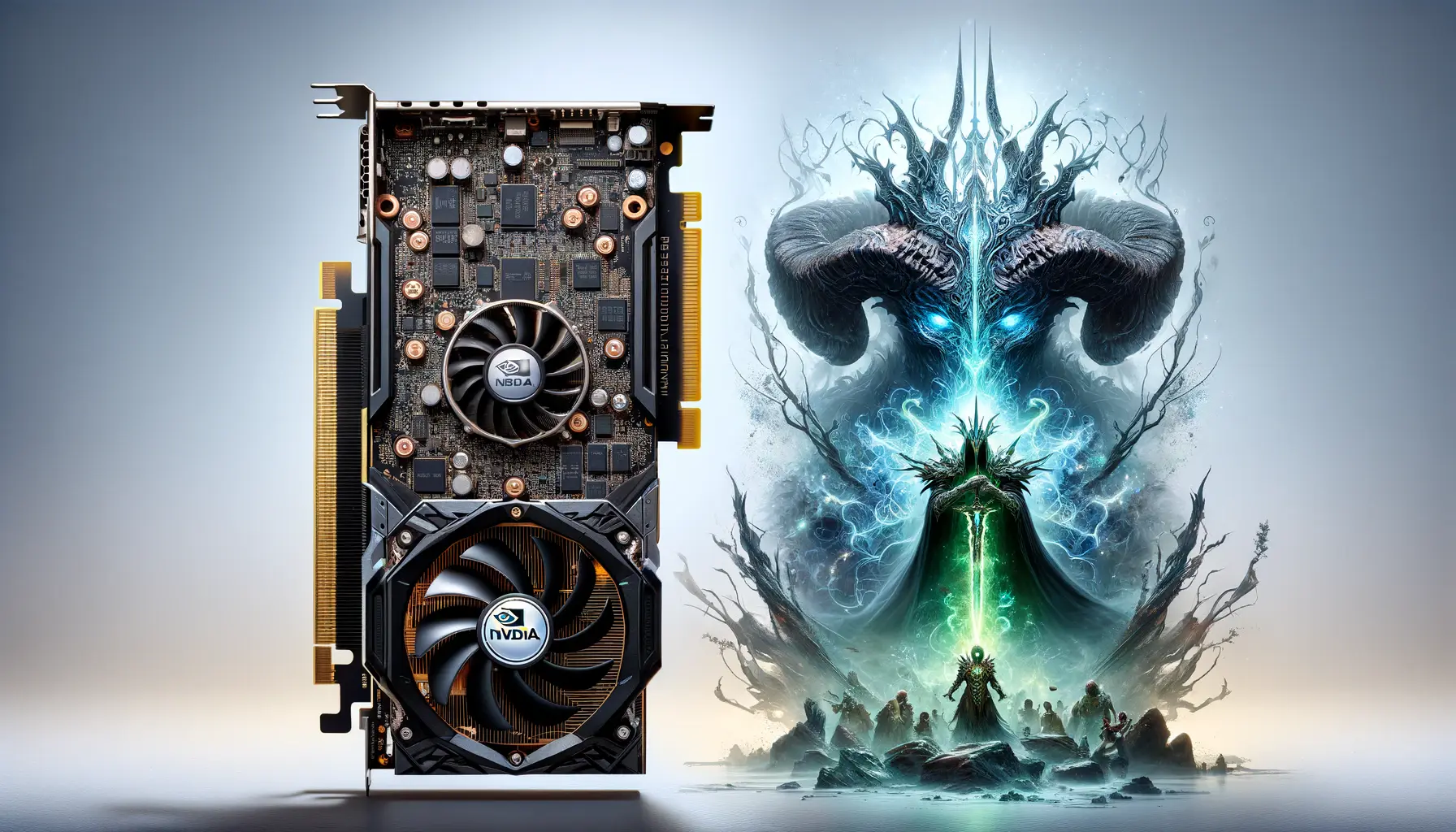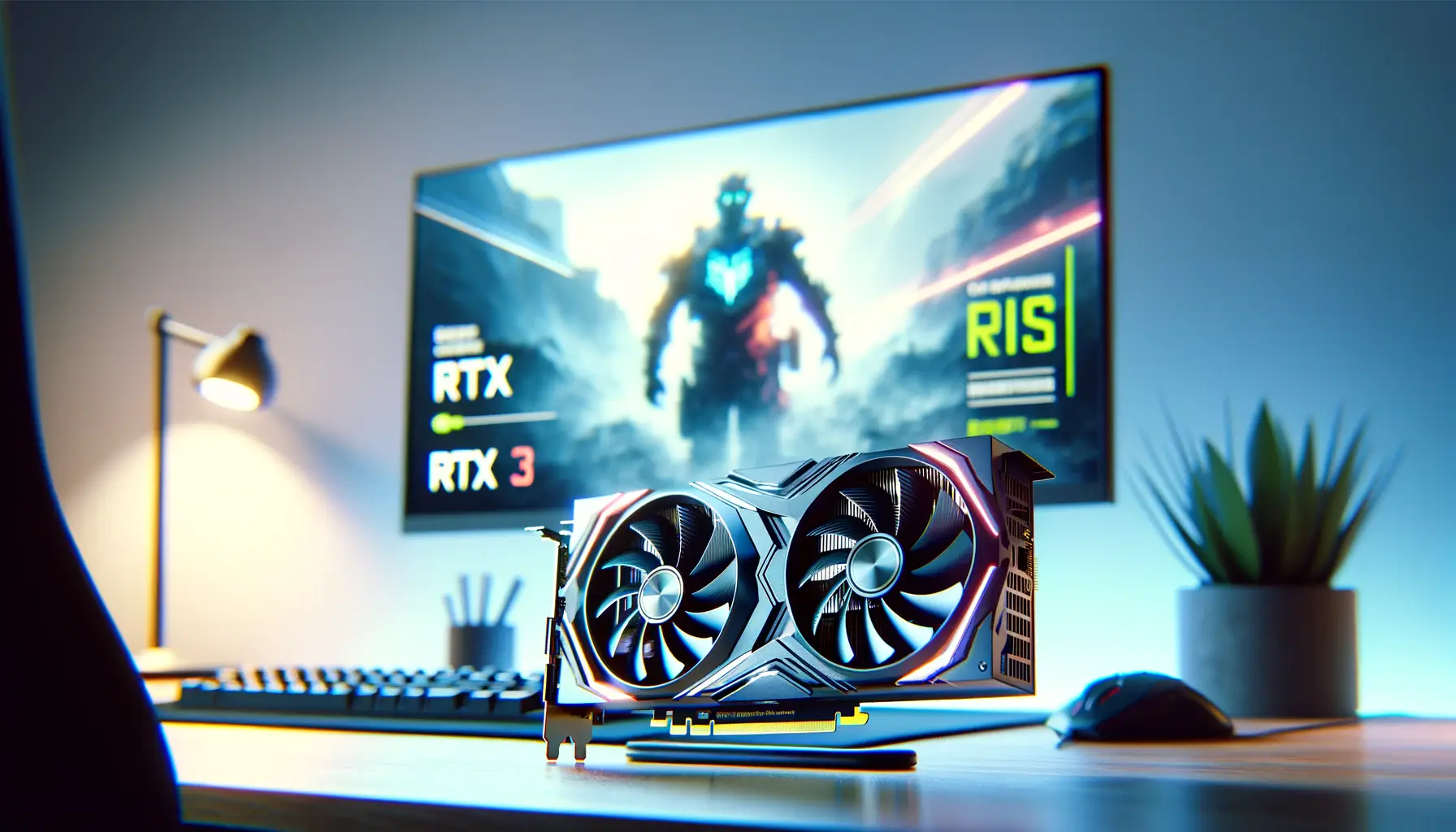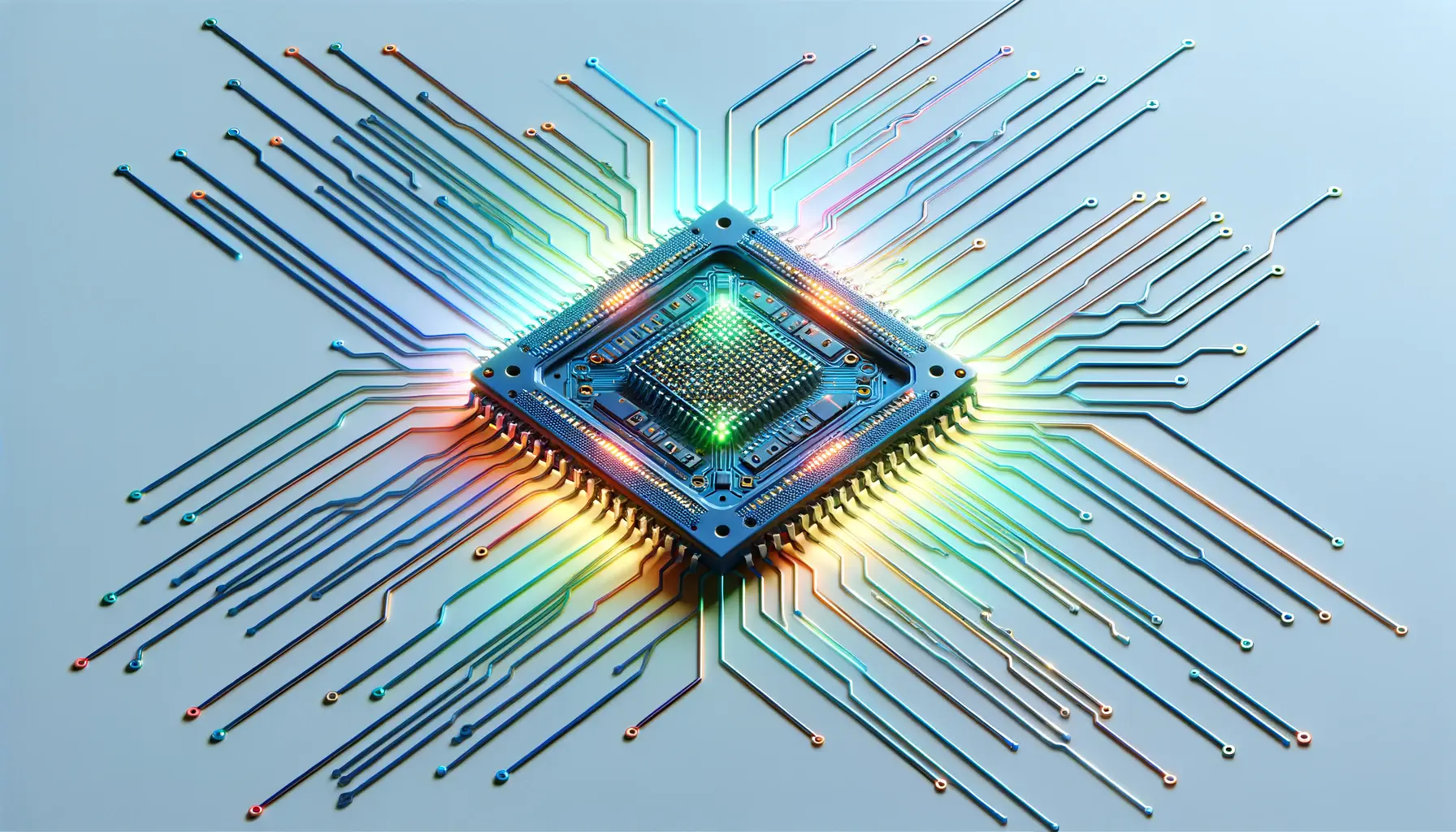Deep Learning Super Sampling (DLSS) technology, particularly its third iteration, represents a significant leap forward in the realm of gaming graphics and performance optimization.
Developed by NVIDIA, DLSS 3 harnesses the power of artificial intelligence to enhance the gaming experience, offering a blend of visual fidelity and performance previously unattainable with traditional rendering techniques.
This technology not only marks a pivotal moment for gamers but also for developers seeking to push the boundaries of what’s possible in virtual environments.
At its core, DLSS 3 is about scaling; not just in terms of resolution, but scaling the very potential of gaming hardware.
By intelligently generating high-quality images from lower-resolution inputs, DLSS 3 allows games to run at higher frame rates without compromising on visual quality.
This is achieved through a complex interplay of machine learning algorithms and dedicated hardware found in NVIDIA’s RTX series GPUs, making it a cornerstone of modern gaming graphics technology.
DLSS Technology
What is DLSS?
Deep Learning Super Sampling (DLSS) is an NVIDIA-exclusive technology that applies neural networks and AI to graphics rendering.
The goal is to increase frame rates by rendering fewer pixels while maintaining or even enhancing the image quality of the game.
DLSS achieves this by initially rendering a game at a lower resolution and then using AI to upscale the image to the desired output resolution, filling in the gaps with intelligent guesswork informed by deep learning.
This process not only boosts performance by reducing the workload on the GPU but also enhances image quality by addressing common issues such as jagged edges and shimmering textures.
It’s a win-win for gamers, offering smoother gameplay and sharper visuals, especially in demanding titles that require significant graphical power.
The Evolution of DLSS
DLSS has evolved significantly since its inception.
The first version of DLSS was impressive but faced criticism for its heavy reliance on external training for each game, which could lead to less than ideal results in terms of image clarity and detail.
NVIDIA responded with DLSS 2.0, introducing a generalized AI model that no longer required per-game training.
This version was a game-changer, offering vastly improved image quality and performance across all supported titles without the need for specific game profiles.
DLSS 3, the latest iteration, takes things a step further by incorporating frame generation technology.
This means it doesn’t just upscale images but also generates entirely new frames in between those rendered by the game engine, effectively increasing the frame rate and making gameplay even smoother.
This leap in technology demonstrates NVIDIA’s commitment to pushing the boundaries of gaming performance and visual quality.
DLSS 3 represents the pinnacle of gaming graphics technology, combining AI-driven upscaling with frame generation to deliver unparalleled performance and image quality.
DLSS 3’s Impact on Gaming Performance
The introduction of DLSS 3 has significantly altered the gaming landscape, offering a blend of high performance and visual fidelity that was once thought to be mutually exclusive.
This technology has made it possible for gamers to enjoy their favorite titles at higher frame rates without sacrificing the quality of the graphics, a feat that has far-reaching implications for both game development and the overall gaming experience.
Enhanced Frame Rates
One of the most immediate benefits of DLSS 3 is its ability to boost frame rates.
By rendering games at a lower resolution and then intelligently upscaling, DLSS 3 reduces the graphical load on the GPU.
This allows for smoother gameplay, particularly in graphically intensive titles that would otherwise require top-tier hardware to run at acceptable frame rates.
The difference is especially noticeable in 4K gaming, where DLSS 3 can double or even triple the number of frames per second (FPS).
Improved Visual Quality
Despite the lower initial rendering resolution, DLSS 3’s AI algorithms are capable of generating images that rival or surpass native resolution quality.
This is achieved through a process known as temporal feedback techniques, where the AI utilizes data from multiple frames to predict and construct high-quality images.
The result is a cleaner, more detailed visual output with reduced artifacts, making for a more immersive gaming experience.
- Reduction of Jagged Edges: DLSS 3 effectively smoothens out jagged edges, a common issue in lower-resolution gaming.
- Texture Sharpening: Textures appear more detailed and crisp, enhancing the overall visual appeal of the game environment.
- Artifact Correction: DLSS 3 addresses visual artifacts such as flickering or blurring, which can detract from the gaming experience.
Game Compatibility and Support
For DLSS 3 to work its magic, games need to be specifically supported and optimized for the technology.
NVIDIA has been actively working with developers to expand the roster of DLSS-enabled games, which has grown significantly since the technology’s introduction.
This collaboration ensures that gamers have a broad selection of titles to enjoy with enhanced performance and visual quality, from blockbuster AAA games to indie favorites.
As the technology matures, the list of supported games continues to grow, making DLSS 3 a more compelling feature for gamers considering an NVIDIA GPU.
The ease of integration for developers, coupled with the tangible benefits for gamers, suggests that DLSS will continue to be a key feature in the future of gaming graphics technology.
The synergy between DLSS 3’s frame rate enhancement and visual quality improvement redefines gaming performance standards, setting a new benchmark for what gamers can expect from their hardware.
The Role of AI in DLSS 3
The groundbreaking performance of DLSS 3 is largely attributed to its sophisticated use of artificial intelligence.
By leveraging AI, DLSS 3 transforms the process of image rendering and frame generation, setting a new standard for efficiency and quality in gaming graphics.
This section delves into how AI powers DLSS 3 and the implications of this technology for future gaming experiences.
AI-Driven Image Upscaling
At the heart of DLSS 3’s AI-driven approach is a neural network specifically trained to upscale images in a way that mimics the quality of higher resolutions.
This neural network, trained on a vast dataset of high-quality game footage, learns to predict the best possible output for each pixel, resulting in images that are not only higher in resolution but also clearer and more detailed than what traditional upscaling methods can achieve.
- Temporal Feedback: DLSS 3 utilizes temporal feedback to enhance image quality over time, drawing on previous frames to improve the accuracy and detail of subsequent ones.
- Real-Time Rendering: Despite the complexity of its AI algorithms, DLSS 3 operates in real-time, ensuring that the enhanced visuals do not come at the cost of performance.
Frame Generation Technology
Beyond upscaling, DLSS 3 introduces an innovative frame generation technology.
By analyzing consecutive frames, the AI predicts and inserts new frames in between, effectively increasing the game’s frame rate.
This not only makes gameplay smoother but also reduces the perceived latency, providing a more responsive gaming experience.
- Enhanced Smoothness: The additional frames make motion in games appear more fluid, enhancing the realism of fast-paced action.
- Reduced Input Lag: By increasing the frame rate, DLSS 3 helps to minimize the delay between player input and on-screen action, crucial for competitive gaming.
Challenges and Solutions
Implementing AI in real-time graphics processing presents unique challenges, particularly regarding the balance between performance and quality.
DLSS 3 addresses these challenges through continuous learning and optimization, ensuring that the AI models are always improving and adapting to new games and graphical demands.
- Continuous Learning: NVIDIA regularly updates DLSS models to refine image quality and compatibility with new titles, ensuring that gamers always enjoy the best possible experience.
- Customization Options: Gamers can choose between different DLSS settings, such as Quality, Balanced, and Performance modes, to tailor the balance between image quality and frame rate to their preference.
AI is the cornerstone of DLSS 3, enabling unprecedented improvements in both image quality and gaming performance through intelligent upscaling and frame generation.
Comparing DLSS 3 with Other Technologies
DLSS 3 stands out as a pioneering technology in the realm of gaming graphics, but it’s not without competition.
Various other technologies aim to improve game performance and visual quality, each with its own approach and methodology.
Understanding how DLSS 3 compares to these alternatives can provide insight into its unique advantages and potential areas for further development.
DLSS vs. FSR (FidelityFX Super Resolution)
AMD’s FidelityFX Super Resolution (FSR) is often cited as a direct competitor to NVIDIA’s DLSS.
While both technologies aim to improve game performance through upscaling, they differ significantly in their approach.
FSR uses spatial upscaling techniques without AI, relying on algorithms to enhance image quality based on the game’s existing frames.
This makes FSR more broadly compatible with a range of hardware, including older GPUs, but it lacks the AI-driven predictive capabilities that allow DLSS to generate higher-quality images and additional frames.
DLSS vs. Traditional Anti-Aliasing Techniques
Traditional anti-aliasing techniques, such as MSAA (Multisample Anti-Aliasing) and FXAA (Fast Approximate Anti-Aliasing), have been used for years to smooth out jagged edges in games.
However, these methods often come with a significant performance cost and can be less effective at higher resolutions.
DLSS, by contrast, not only addresses the issue of aliasing but also improves overall image quality and game performance, offering a more comprehensive solution.
DLSS vs. Native Resolution Rendering
Rendering games at native resolution is the traditional method for achieving the highest image quality, but it’s also the most demanding on hardware.
DLSS offers an alternative by providing similar or even superior image quality at a fraction of the computational cost.
This allows gamers to enjoy high-resolution gaming experiences without needing the most powerful hardware on the market.
- Performance: DLSS significantly outperforms native resolution rendering in terms of frame rate, making it ideal for high-resolution gaming.
- Quality: With its AI-driven approach, DLSS can match or even surpass the visual quality of native resolution in many cases.
- Accessibility: DLSS opens up high-quality gaming experiences to a wider range of hardware, not just the latest high-end GPUs.
While DLSS 3 offers unique benefits in performance and quality through AI, understanding its position relative to other technologies highlights its role in the evolving landscape of gaming graphics.
Optimizing Games with DLSS 3
Integrating DLSS 3 into games is a transformative process that not only enhances visual fidelity and performance but also extends the capabilities of gaming hardware.
Developers and gamers alike can leverage DLSS 3 to optimize gaming experiences, pushing the boundaries of what’s possible in terms of graphics and smooth gameplay.
This part explores the practical aspects of optimizing games with DLSS 3, from development considerations to user settings.
For Game Developers
For developers, incorporating DLSS 3 into games involves collaboration with NVIDIA to ensure that the technology is seamlessly integrated and fully optimized for their titles.
This process includes:
- Accessing NVIDIA’s SDK and tools designed specifically for DLSS integration.
- Training the DLSS model on high-quality assets to ensure the AI can accurately upscale images and generate frames.
- Testing and tweaking the implementation to balance performance gains with visual quality across a range of hardware.
By adopting DLSS 3, developers can significantly enhance the appeal of their games, offering superior performance and visual quality that can set their titles apart in a competitive market.
For Gamers
For gamers, DLSS 3 provides a suite of options to customize their gaming experience based on their hardware and preferences.
Adjusting DLSS settings can help find the perfect balance between image quality and performance:
- Quality Mode: Focuses on maximizing image quality, ideal for gamers with high-end GPUs looking to enjoy the best visuals without significant performance hits.
- Performance Mode: Prioritizes frame rate, suitable for those willing to sacrifice some visual fidelity for smoother gameplay, especially on mid-range hardware.
- Ultra Performance Mode: Designed for the highest possible frame rates, best used in extremely demanding scenarios or for VR and high-resolution gaming.
Understanding and experimenting with these settings allows gamers to tailor their experience, ensuring that they can enjoy their favorite titles in the best possible quality their hardware can support.
Optimizing games with DLSS 3 involves a collaborative effort between developers and NVIDIA, while gamers have the flexibility to adjust settings for an ideal balance of quality and performance.
Future of Gaming Graphics with DLSS 3
The advent of DLSS 3 marks a significant milestone in the evolution of gaming graphics, offering a glimpse into the future of how games will be developed and experienced.
Its impact extends beyond mere performance improvements, hinting at new possibilities for game design, accessibility, and immersion.
This section explores the potential future developments in gaming graphics, driven by DLSS 3 and similar technologies.
Enhanced Realism and Immersion
DLSS 3’s ability to deliver high-quality visuals at unprecedented frame rates paves the way for more realistic and immersive gaming experiences.
Future games could feature even more detailed environments, complex lighting effects, and lifelike character animations, all running smoothly on a wider range of hardware.
This level of realism will not only enhance the visual appeal of games but also deepen the level of immersion, making virtual worlds more convincing and engaging.
Accessibility and Inclusivity
By enabling high-quality gaming experiences on less powerful hardware, DLSS 3 contributes to greater accessibility in gaming.
Players will not need to invest in the most expensive GPUs to enjoy the latest titles at their best, making gaming more inclusive.
This democratization of high-end gaming experiences could lead to a broader audience for new and demanding titles, encouraging developers to push the boundaries of game design without worrying about alienating players with less powerful systems.
Innovation in Game Development
DLSS 3 offers developers the freedom to experiment with more resource-intensive graphics and physics effects without the traditional constraints of hardware performance.
This could lead to innovative new game mechanics, more dynamic and interactive game worlds, and even new genres that fully exploit the capabilities of advanced AI-driven graphics technologies.
As developers become more familiar with DLSS 3, we can expect to see games that were previously unimaginable, thanks to the computational efficiency and visual quality it provides.
The future of gaming graphics, shaped by DLSS 3, promises not only more beautiful and fluid games but also a more inclusive and innovative gaming landscape.
DLSS 3 and the Broader Ecosystem
DLSS 3’s influence extends beyond individual games, impacting the broader gaming ecosystem, including hardware development, software optimization, and even the competitive landscape of gaming technologies.
Its role in shaping the future of gaming is multifaceted, affecting how games are played, developed, and experienced on a global scale.
Impact on Hardware Development
The development and adoption of DLSS 3 are closely tied to advancements in hardware, particularly NVIDIA’s RTX series GPUs.
This symbiotic relationship encourages continuous innovation in GPU technology, with each new generation designed to leverage DLSS more effectively.
As a result, future hardware developments are likely to focus on enhancing AI capabilities and efficiency, further improving the performance and visual quality of games enabled by DLSS 3.
Software Optimization and Compatibility
DLSS 3 also plays a crucial role in software optimization, encouraging developers to integrate AI-driven techniques into their game design and optimization processes.
This shift towards AI-enhanced graphics is likely to influence the development of game engines and tools, making DLSS compatibility a standard feature.
Additionally, as DLSS technology becomes more widespread, we can expect broader support across a range of titles, from indie games to AAA blockbusters, enhancing the gaming experience across the board.
Competitive Landscape of Gaming Technologies
The success of DLSS 3 has set a new benchmark for gaming graphics technologies, prompting competitors to develop their own solutions.
This competitive environment fosters innovation, leading to rapid advancements in graphics technology.
Gamers stand to benefit from this competition, as companies strive to provide the best possible performance and visual quality.
The evolution of DLSS and similar technologies will continue to drive the gaming industry forward, shaping the future of gaming graphics in exciting ways.
DLSS 3’s impact on the gaming ecosystem highlights its importance not just for gamers and developers, but also for the future direction of hardware innovation and the competitive dynamics of gaming technologies.
Embracing the Future with DLSS 3
As we’ve explored the intricacies and impacts of DLSS 3, it’s clear that this technology is not just a fleeting advancement in gaming graphics but a transformative force reshaping the landscape of digital entertainment.
By intelligently blending AI with graphics rendering, DLSS 3 has set a new standard for what gamers can expect in terms of performance and visual quality.
This conclusion aims to encapsulate the essence of DLSS 3, reflecting on its journey and envisioning the path it lays for the future of gaming.
The Pinnacle of Gaming Graphics
DLSS 3 represents the culmination of NVIDIA’s efforts to harmonize the demands of high-fidelity graphics with the realities of hardware limitations.
Through its innovative use of deep learning, DLSS 3 offers a glimpse into a future where games not only look better but run smoother on a wider array of hardware.
This technology has democratized access to premium gaming experiences, making them more accessible to a broader audience and ensuring that the joy of gaming is not confined to those with high-end PCs.
A Catalyst for Innovation
The introduction of DLSS 3 has also served as a catalyst for innovation within the gaming industry.
Game developers are now empowered to push the boundaries of creativity and immersion, knowing that DLSS 3 can bridge the gap between their vision and the player’s experience.
This has opened up new possibilities for storytelling, game design, and interactive experiences, setting the stage for a new era of gaming that was once thought to be decades away.
- Enhanced realism and detail in game environments
- More fluid and lifelike animations and character movements
- Greater immersion through improved visual effects and lighting
Shaping the Future of Gaming
Looking ahead, the trajectory of DLSS 3 and similar technologies is poised to redefine our understanding of gaming performance and quality.
As AI becomes more integrated into game development and rendering processes, we can anticipate a future where games are not only visually stunning and highly performant but also more responsive and immersive.
The potential for DLSS 3 to influence future gaming hardware, software optimization, and even the competitive landscape of gaming technologies is immense, promising a bright future for gamers and developers alike.
In conclusion, DLSS 3 is more than just a technological achievement; it’s a beacon for the future of gaming.
It challenges the status quo, redefines possibilities, and sets a new course for the evolution of gaming graphics.
As we stand on the brink of this new era, one thing is clear: the future of gaming, powered by DLSS 3 and its successors, is not just bright; it’s dazzling.
DLSS 3: Frequently Asked Questions
Explore the most common inquiries about DLSS 3, NVIDIA’s groundbreaking technology that’s reshaping gaming graphics.
DLSS 3 is NVIDIA’s AI-accelerated resolution rendering technology, enhancing frame rates and game performance on RTX 40 Series GPUs.
DLSS 3 uses AI to upscale lower-resolution images, generating high-quality visuals and inserting new frames for smoother gameplay.
DLSS 3 introduces frame generation technology, offering significant performance improvements over its predecessors by creating additional frames.
Older RTX cards can benefit from DLSS 3’s improvements, except for the frame generation feature, which is exclusive to the RTX 40 series.
Over 35 games and apps currently support DLSS 3, including Marvel’s Spider-Man Remastered and Microsoft Flight Simulator, with more to come.
DLSS 3 provides comparable or superior image quality to native resolution while offering significantly higher frame rates and better performance.
Does DLSS 3 improve game latency?
[/title][desc]Yes, DLSS 3 reduces game latency by increasing frame rates and leveraging NVIDIA Reflex, enhancing responsiveness and gameplay smoothn













